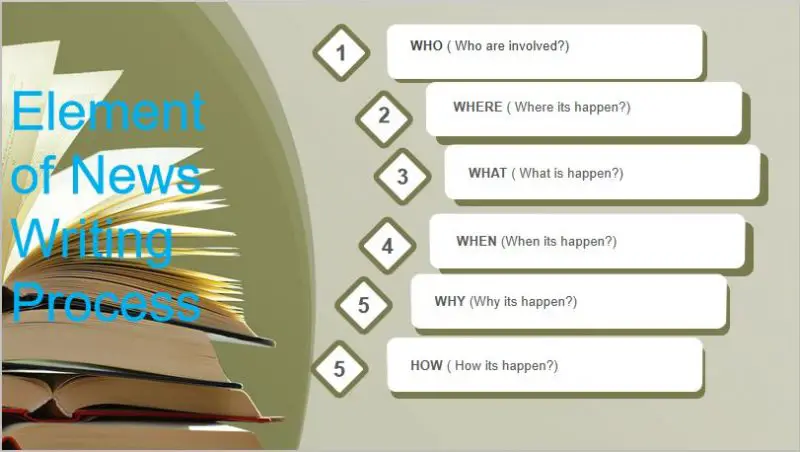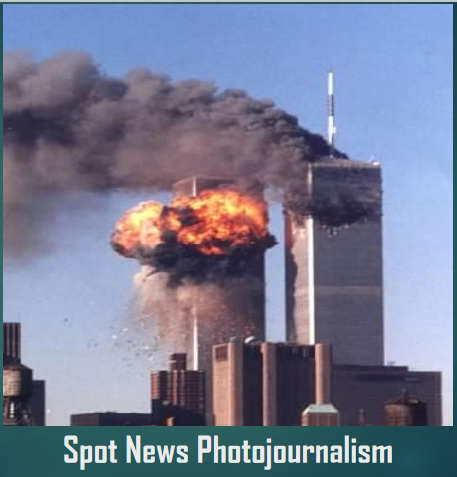5W and 1H of Report Writing in Journalism, Types of News Reporting in Journalism. Example of News Writing Process. 5ws and 1h Example.
5W and 1H of Report Writing
The 5 WS and 1H of report writing refer to the inverted pyramid style of news writing in which journalists present essential info at the top by answering the who, where, what, when, why, and how questions. A reporter answers all these five w’s and one h questions throughout the news lead. Therefore, these are the essential elements that the reporter should keep in mind while writing and publishing a news story. It improves the news values in journalism. For example, the writer must follow the 5 Ws and 1H news writing methods to achieve the completeness of news value in journalism.
- Who (who is involved?)
- Where (where did it happen?)
- What (what is happening?)
- When (when did it happen?)
- Why (why did it happen?)
- Also, how (how it happens?)

Different Types of Journalism
News Writing Process
The news writing process will help you to know how to write a complete news article. It also represents the essential elements of a news story and how to follow them individually.
News Report Writing Format and Example
The eight elements of a news report or newspaper article are:
- Title/ Headline
- Author name/ Byline
- Dateline
- Lead
- Body
- Conclusion
- Photo
- Caption
1. Title/Headline
The headline is the most crucial element of a news report to attract readers to read the full article. An excellent perfect headline also concludes the news.
Elements of the Title or Headline
A good headline or title should be 1. Provocative, 2. Functional, 3. Simple, 4. Informal, 5. Relevant, also 6. Representative.
Example of Headline- Government officials accepting bribes are hunted
-
Byline/ Author Name
For example,
Government Officials Accepting Bribes are Hunted
By: M M Kobiruzzaman
-
Dateline
For example,
Government Officials Accepting Bribes are Hunted
By: M M Kobiruzzaman
KUALA LUMPUR 2 July
-
Lead
Lead writing is the most critical section of the news for readers to understand the entire message of the news story from this section. The news lead presents the most newsworthy and essential information to attract readers to read the entire article. Therefore, journalists use the 5 WS and 1H report writing strategy to introduce the importance of news. The writers widely use the five w and one h news writing approaches for the lead section. A good lead highlights the central info of the report. However, a good news lead never exceeds 25-35 words.
The inverted pyramid news-writing formula includes three essential parts of an ideal news story: the lead, body, and tail.
For example,
Government Officials Accepting Bribes are Hunted
By: M M Kobiruzzaman
KUALA LUMPUR 2 July
Lead 1: KUALA LUMPUR 2 July - The malaysian anti -corruption commission (sprm) has detected several government officials suspected of being involved in corrupt activities in cameron highlands.
Lead 2: Government officials are suspected among the recipients of bribes that are the cause of government efforts to restore environmental damage in cameron highlands failed.
-
News Body or Details Info
The news body refers to the main content of the news reporting that describes and explains the facts. It is the report’s prime part; it presents the whole story of the issue. If the full report covers seven paragraphs, usually, the body starts with paragraph 3 until 5.
For example,
Government Officials Accepting Bribes are Hunted
By: M M Kobiruzzaman
KUALA LUMPUR 2 July
Lead 1: KUALA LUMPUR 2 July - The malaysian anti -corruption commission (sprm) has detected several government officials suspected of being involved in corrupt activities in cameron highlands.
Lead 2: Government officials are suspected among the recipients of bribes that are the cause of government efforts to restore environmental damage in cameron highlands failed.
Body 1: Sources said the MACC will make follow -up arrests on the issue of leakage in Cameron Highlands soon.
Body 2: “If before, we arrested the bribe givers but after this we will conduct the same operation to hunt down those who accept bribes. Anyone including government officials and middlemen who helped launch the bribery process will be arrested.
Body 3: "We will also not hesitate to take action even against those in authority in the case of land encroachment there," said a source involved in the corruption investigation in Cameron Highlands here today.
-
Tails
The conclusion again highlights the central fact of the issues that have already been reported on the lead and news body.
For example,
Conclusion 1: Meanwhile, the director of the sprm intelligence division, Datuk Azam Baki, when contacted, stressed that his party would never compromise if there was any element of corruption involving government officials or enforcement officers in the issue.
Conclusion 2: “those arrested were bribe givers and the results of our further investigation have identified those who received bribes. further action will be taken, "he said
News Article with 5w and 1h Example
Government Officials Accepting Bribes are Hunted
By: M M Kobiruzzaman
KUALA LUMPUR 2 July
Lead 1: KUALA LUMPUR 2 July - The malaysian anti -corruption commission (sprm) has detected several government officials suspected of being involved in corrupt activities in cameron highlands.
Lead 2: Government officials are suspected among the recipients of bribes that are the cause of government efforts to restore environmental damage in cameron highlands failed.
Body 1: Sources said the MACC will make follow -up arrests on the issue of leakage in Cameron Highlands soon.
Body 2: “If before, we arrested the bribe givers but after this we will conduct the same operation to hunt down those who accept bribes. Anyone including government officials and middlemen who helped launch the bribery process will be arrested.
Body 3: "We will also not hesitate to take action even against those in authority in the case of land encroachment there," said a source involved in the corruption investigation in Cameron Highlands here today.
Conclusion 1: Meanwhile, the director of the sprm intelligence division, Datuk Azam Baki, when contacted, stressed that his party would never compromise if there was any element of corruption involving government officials or enforcement officers in the issue.
Conclusion 2: “those arrested were bribe givers and the results of our further investigation have identified those who received bribes. further action will be taken, "he said
Types of News Reporting in Journalism
The 5 WS and 1H of report writing strategy are applicable for all types of news report writing including crime, sports, economic, disaster, and feature news reporting.
- Crime News Reporting
- Sports News Reporting
- Economic News Reporting
- Disaster news reporting
- Features News Reporting
1. Crime News Reporting
Crime news reporting refers to reporting related to crime issues, including police, victims, and criminals.
2. Sports News Reporting
Sports News Reporting means writing and publishing news related to the development of the sports industry locally or internationally.
3. Economic News Reporting
Economic News Reporting means news writing related to the economic and financial system in-country or worldwide.
4. Disaster News Reporting
Disaster News Reporting means news reporting that will affect the emotions of the involved victim.
5. Features News Reporting
The most common types of features in journalism are profile, review, round-up, how-to, personal expertise, and travel feature writing.
What Should Journalists Report?
Firstly, the journalist should report the severe issues in society.
The journalist reports great crime news in the society or community.
Finally, a journalist should report the local crime to the identity of the criminal and victim.




